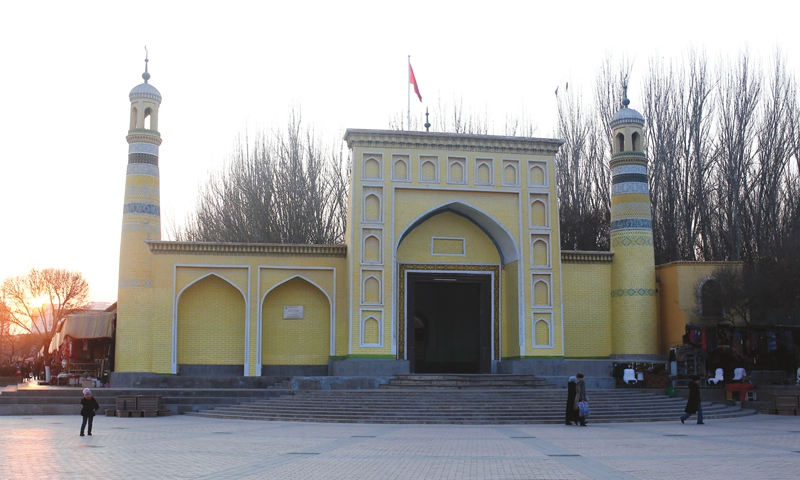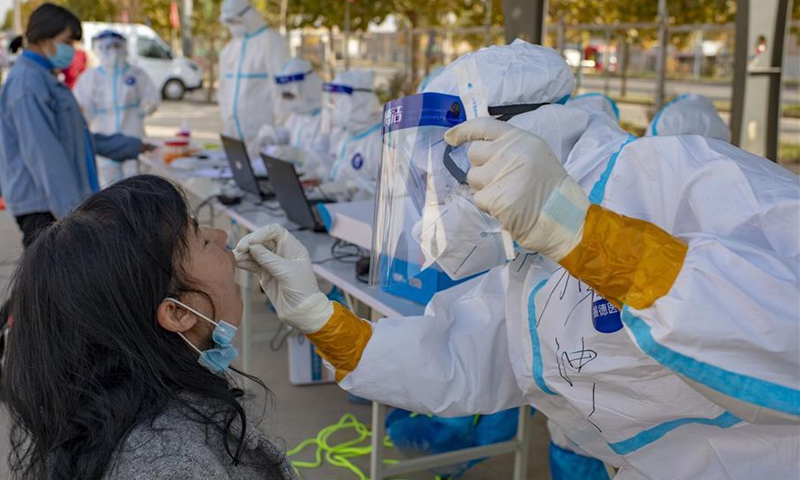Kashi tests all 4.7 million residents, finds no infection beyond Shufu county
By Liu Caiyu Source: Global Times Published: 2020/10/27 21:38:40
Positive cases rise to 183 but no infection found beyond Shufu county

A mosque in Kashi, Xinjiang Uygur Autonomous Region opens to the public. Photo: Shan Jie/GT
The four-day prefecture-wide nucleic acid testing of 4.7 million people in Kashi of Northwest China's Xinjiang Autonomous Region discovered no other infections beyond the clustered epidemic related to a factory in Shufu county. Viral gene sequencing also ruled out the possible link between Kashi's outbreak and a previous one in Urumqi in July, which is believed to be factual evidence that the epidemic is merely a controllable clustered epidemic with a low risk of community transmission.
Health officials in Kashi on Tuesday afternoon reported five confirmed COVID-19 cases that were previously asymptomatic, and another 19 asymptomatic patients, bringing the total positive cases to 183, all linked to Shufu county.
All 4.7 million people in the Kashi region had undergone nucleic acid testing as of Tuesday afternoon. No other positive results were found in the other regions of Kashi, said a local health commission official.
"The outbreak in Kashi is a regional clustered infection," Zhang Yuexin, a member of Xinjiang's anti-epidemic group, which is offering medical treatment in Kashi, told the Global Times on Tuesday. "The chances that the virus is spreading across the whole Kashi region and Xinjiang are extremely slim… a daily spike of 100 infections seems unlikely to occur again," Zhang said.
The first asymptomatic infection in Kashi was found in a factory at Shufu county, which is 15 kilometers from downtown Kashi.
The daily life of factory workers is basically confined within the county, Zhang said, thus all positive results linked to the clustered cases largely eliminate the possibility of community transmission, the medical expert noted.
Unlike the latest epidemic in Urumqi in July, when the entire region was locked down, and the lives of people were brought to a standstill, Kashi adopted a much more precise anti-epidemic measure. Kashi city remains open and outbound tourists are allowed to leave with a negative nucleic acid report. Beyond that, only the most-affected four villages under Shufu county were labeled as high-risk areas, the Global Times learned.
Stores, shopping malls and restaurants in villages near Shufu county have temporarily closed. Business operators have to stay home for days, and live on food delivered by community workers.

A medical worker collects a sample from a person for nucleic acid testing in Shufu County of Kashgar Prefecture, northwest China's Xinjiang Uygur Autonomous Region, Oct. 26, 2020. Northwest China's Xinjiang Uygur Autonomous Region identified 26 new asymptomatic cases of COVID-19 between 4 p.m. Sunday and 4 p.m. Monday, a local health official said at a press conference on Monday. All the new cases were reported in Shufu County, south Xinjiang's Kashgar Prefecture. (Xinhua/Hu Huhu)
Zhou Ting (pseudonym) has been on duty at a hotel in Shufu for four days since the outbreak began.
"The outbreak kept me from going home and I'm on duty all day by myself," Zhou said. She usually takes turns with another colleague in two shifts a day.
The 30-room hotel used to be popular with tourists but now most rooms are occupied by staff from the anti-epidemic group and health department. The hotel is only few kilometers from the clothing factory where the silent carriers worked.
"I feel less nervous after knowing all cases were linked to the factory, and no community transmission was detected," Zhou said.
As of Monday afternoon, all 245,000 residents in Shufu county had been tested. To ensure accuracy, key clusters of the county will undergo a second round of testing.
Pateguri, a medical worker from a hospital in Shufu, told media that the local nucleic acid testing team of 10 medical staff is able to collect 500 throat swabs in an hour.
But that doesn't mean zero risks.
The community where Miao (pseudonym) lives remain closed. Miao said she has been at home since Saturday. "Most communities in Kashi city are still under closed management. The once-bustling streets of Kashi city are deserted," Miao told the Global Times on Tuesday.
She's been living on food and other daily necessities that she purchased since Saturday. "I went to clubs before the outbreak, so I was only a bit relieved after getting a negative nucleic acid test," she said.
Zhang Yuexin, a member of Xinjiang's anti-epidemic group, said people should continue to maintain social distances, stay home and wear masks when going out.
The local government of Kashi will continue to trace the infection source, which is challenging as all asymptomatic cases had no contact history with fever patients, or cold chain products and wild animals, Zhang noted.
On a self-driving tour in Xinjiang with three friends, Yang Zi, from East China's Anhui Province, said the Kashi outbreak was the closest that he had come to the novel coronavirus. "I was worried in the beginning but the swift response by the government relieved our concerns."
Holding a negative report of nucleic acid testing, Yang is headed to Urumqi, a city 1,500 kilometers from Kashi. "I expect to finish the trip in three or four days and return home. Urumqi is safe from COVID-19."
Newspaper headline: Kashi tests all 4.7 million residents
Posted in: SOCIETY